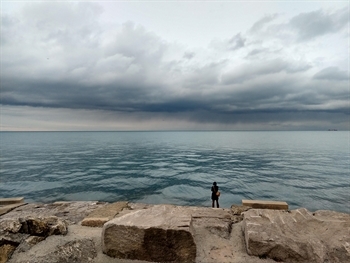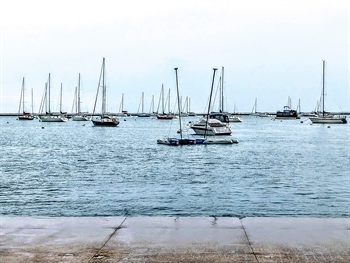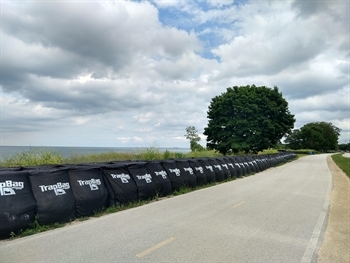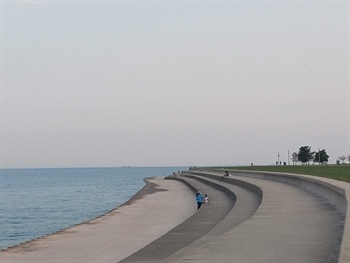City by the Lake in the Era of Accelerating Climate Change
Sea level rise? No. Wildfires? Unlikely. But recently everyone’s been buzzing about “The Battle Between a Great City and a Great Lake,” an interactive New York Times feature that explains why Chicago doesn’t get a pass from climate change. (If you don’t have an NYT subscription, you can read the article without the visualizations here.) As I said in my interview for the City Cast Chicago podcast, the article is so expansive that it left a lot of people wondering, “What should I do with this information? How do we fix these big problems?”
Among the issues discussed in the New York Times, here are two of the big ones:
PROBLEM: Fluctuating Lake levels
Changing temperature and precipitation patterns mean longer periods of dry followed by shorter, more intense storms.
Lake Michigan reached a record high in 2020 after years of above-average precipitation, including three consecutive record-breaking May rain totals. The lake is still high now, despite there being severe drought conditions across much the Upper Midwest, including in northern Illinois.
As anyone who has stood on the shores of Lake Michigan can tell you, it’s big! It takes time for levels to equalize by draining via Lake Huron into Lake Erie, over Niagara Falls, into Lake Ontario, and through the St. Lawrence River on its way to the Atlantic Ocean.

That’s the natural way to lower lake levels. As to whether we should drain more out through the Chicago River and downstream to the Gulf of Mexico, there’s the question of legality. Actually, there’s no question – a Supreme Court decree limits withdrawals to 3,200 cubic feet per second (cfs) which includes all of the drinking water used by 56% of the state’s population. Even maxing out that 3,200 cfs would result in approximately one-inch annual drop in lake levels.
Shorelines fluctuate. That is natural. But rapid swings from high to low water levels are not natural. Those swings are due to climate change. Record rainfall last spring. Drought this spring. That’s what climate change looks like in the Midwest. We don’t need to worry about wildfires. And sea level rise, where the water level is only going up, won’t touch us here. But changing temperature and precipitation patterns mean longer periods of dry followed by shorter, more intense storms.
Essentially, the extremes are getting more extreme, resulting in volatility along the shoreline.

Adaptation and aggressive action
Despite record high lake levels in 2020, it was only seven years earlier when we saw record lows. Now we’re concerned about whether we can drain a too-high Chicago River into the Lake to prevent flood damages during extreme rain events. Then we were concerned whether the lake was high enough to maintain navigable depths in the canal system.
While adaptation is certainly needed, we must take aggressive action to slow climate change. The Metropolitan Mayors Caucus’ recently-released Climate Action Plan for the Chicago Region is an excellent roadmap of actions every community can take now, including steps to reduce emissions, implement clean energy policies, reduce vehicle miles traveled, decarbonize transportation, sustain ecosystems to sequester carbon, and more.
PROBLEM: Erosion and property damage along the shore
When a massive storm blew through in January 2020, waves overtopped shoreline defenses and failed to protect shoreline communities in Rogers Park and South Shore – opposite ends of Chicago’s coast. Large portions of the current shoreline armoring are insufficient for a higher lake level, but shoreline erosion – even for non-record lake levels – is a problem officials have been trying to address for more than a century.
Zoom in on this lithograph of Chicago in 1857 and you can see the Illinois Central Railroad “speeding along the trestle the company constructed as a breakwater in exchange for obtaining this route.” The area around the tracks was later filled in with debris from the Great Chicago Fire, resulting in reclaimed land that is now Grant Park.

One hundred years earlier, Jean-Baptiste Pointe DuSable would have seen a shoreline that looked more like what we still see on the Michigan side of the lake: large, sandy beaches and dunes moving up and down the coast through a natural process known as littoral drift.
Not anymore. On a recent bicycle ride along the lakefront trail near 47th St., I noticed generations of attempts to control the lake. The first level of defense, boulders set in concrete, is currently underwater. The next level (more boulders, more concrete) sits just inches above the water, and erosion on the rocks tells me that years of storms washed right up and over them. Further back from the shoreline, recent emergency interventions in response to last year’s storms include large cubes of poured concrete or giant, black sandbags stretching for hundreds of feet.
What’s next? Should we build higher walls to keep the waves out?
The Army Corps is currently assessing solutions to continue the Chicago Shoreline Protection Project, which will add more protection north of Montrose and south of 47th St. Stepped revetments are a likely solution, but do we want more concrete? More to the point, with an uncertain climate, are we confident we won’t be back in the same situation in another 40 years?

Lakes rise and fall. We can build bigger walls, but we need to think about mimicking the natural, pre-development shoreline in places where it makes sense. According to Tip of the Mitt Watershed Council, “Beaches have been called one of the most effective defense structures in the world. Sand or gravel beaches can resist forces that tear apart rigid structures after a few seasons.”
With development edging right up to the shore in many places, a fully naturalized solution isn’t possible. Whatever the solution, it will involve concrete to be sure, but we need to prioritize proven nature-based infrastructure or those that mimic natural processes to protect shoreline communities. This can include multiple layers of defense, such as offshore reefs, hard armoring of the shoreline, and then a buffer strip planted with diverse native vegetation.
The shoreline should be adaptable, providing spaces for recreation when dry, but strategically designed to withstand higher (and lower) water levels.
Much of the shoreline property is owned by the Chicago Park District, but there are a large number of private property owners, as well. For either group, the selection of specific interventions requires engagement with community members about the risks and trade-offs to arrive at an acceptable solution. A recent Urban Land Institute Chicago report states that building a resilient Chicago must include, “Creating an inclusive, meaningful resident engagement process to prioritize community needs and create community buy-in,” especially for communities of color and low-income communities which are particularly vulnerable to a changing climate. (Chicago’s South Shore neighborhood, has a median income of $32 thousand and is 93% Black, compared to $58 thousand and 29%, respectively, for the City of Chicago as a whole.)
Adaptable solutions
The shoreline should be adaptable, providing spaces for recreation when dry, but strategically designed to withstand higher (and lower) water levels, lashing waves, and storm surges. These decisions should be data-driven, utilizing the data collection and field research conducted by or in partnership with the IDNR Coastal Management Program. Besides residential and commercial properties, roads and other critical infrastructure are at risk, meaning agencies like the state and city Departments of Transportation can be part of the solution. And protection of aquatic ecosystems also needs to be considered in the process.
And, most importantly, we must plan now so that we’re ready to implement when, inevitably, the lake is low again. Lamenting their limited funding to address shoreline erosion in January 2020, David Bucaro of the U.S. Army Corps of Engineers, said, “We’re doing the best we can with what we’ve been given. […] when the lake levels were low, there was no interest in doing preemptive planning to address these issues.”
Let’s learn this lesson and maintain the momentum to implement solutions when record high lake levels and shoreline erosion don’t dominate the headlines.
Sarah J. Howe is a Master of Urban Planning & Policy candidate at the University of Illinois at Chicago with an environmental planning concentration. She is interested in climate change preparedness and mitigation, rural development, community health, and all things water.
